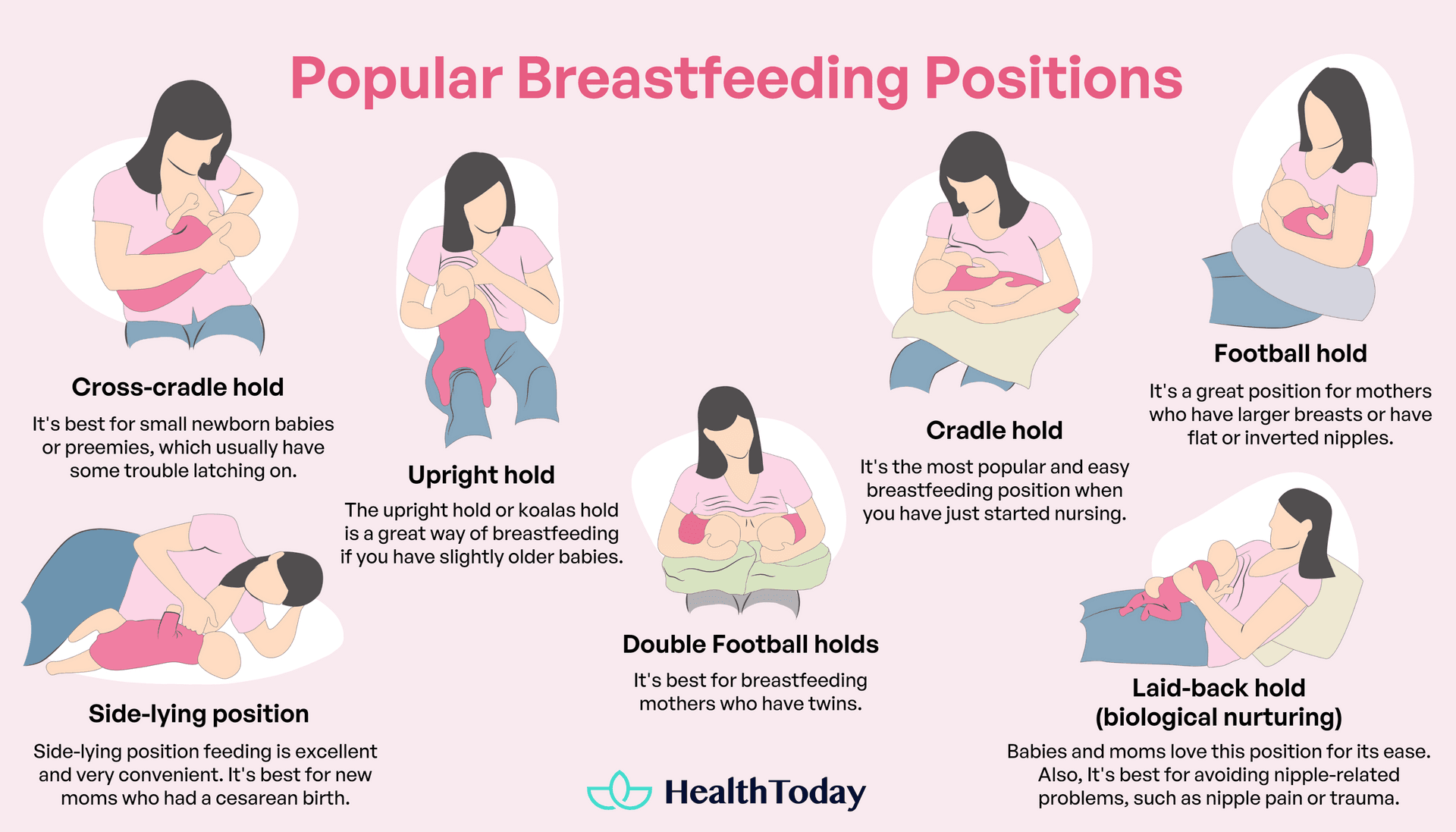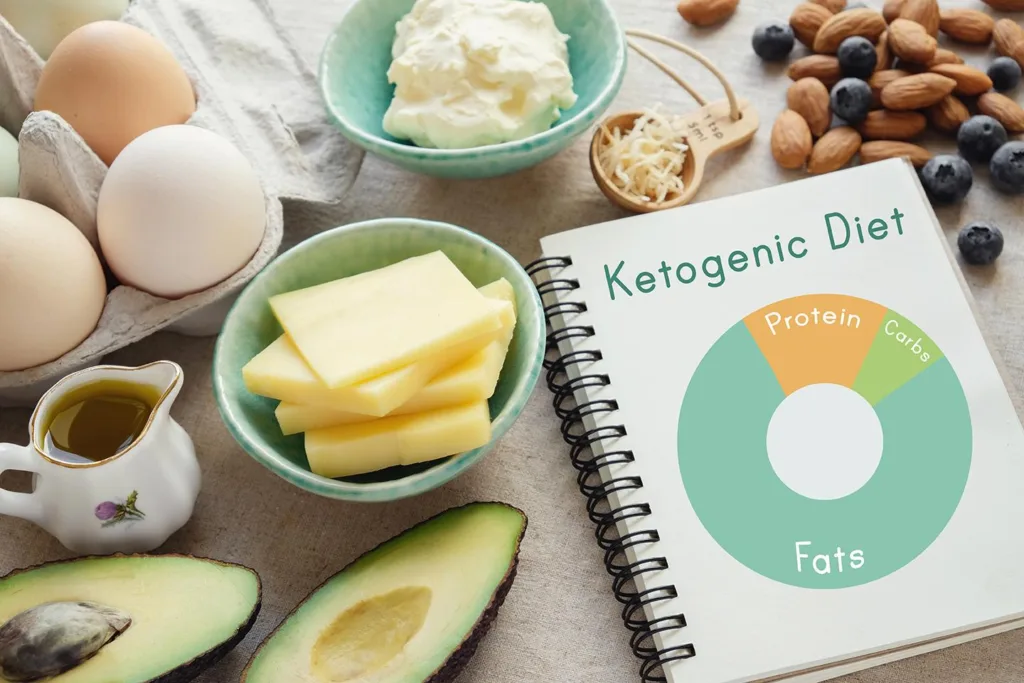Table of Contents
The breastfeeding journey after giving birth is magical. It’s a natural way to bond with the baby, provide them with nutrition, and much more. The reason that it is natural doesn’t mean you will master it on the first day.
Every newborn and mother will take the time to explore breastfeeding positions and other things. The right position will let your baby have the maximum nutrition. To help you, here are different breastfeeding positions and tips from experts and experienced moms.
Nursing positions basics
The benefits of breastfeeding are lifelong. It helps the mother and baby to bond (1). Also, it fulfills nutritional requirements, strengthens the immune system, and reduces the risk of certain diseases (1).
But, the importance of nursing positions is also important. A good position having a proper latch benefits the newborn (2). It helps the baby have the required amount of milk in a comfortable position (3). Also, the mother should be in the most comfortable position.
The perfect and most loved breastfeeding position is different from anyone. Therefore, you may like some positions more with practice and guidance.
No matter what position you choose, you must ensure some things:
Support to the baby: There should be ample support, especially at the neck and head region (4).
Comfortable position: As a mother, you should be in the most comfortable position.
Popular breastfeeding positions

Here are some popular breastfeeding positions you can try:
Cradle hold

This is one of the most popular and easy breastfeeding positions. It is a comfortable position for the first few weeks of nursing.
Follow these steps for cradle-hold breastfeeding (5):
- Sit comfortably on a chair or bed with a pillow at your back.
- Carry the baby’s head on your forearm.
- The baby’s nose should be opposite the nipple.
- Support the body of the baby with the forearm.
- The baby’s lower arm should be under yours.
- Ensure the baby’s ear, shoulder, and hip are straight in line.
- The baby’s head must face your chest.
- Hold your breast above the nipple and let the baby latch it.
Pros:
- It’s a good position when you have just started nursing.
- It’s easy to start with this position.
Cons:
- If you have a cesarean birth, it may not be very comfortable. The baby can press against the incision (6).
Tip: If sitting on a chair, you can place a small stool to rest your feet. This will prevent bending and make you feel a lot more comfortable.
Cross-cradle hold

The cross-cradle position is a brilliant position for small babies. It helps you get more control over babies’ feeding. Like, you can see the baby’s mouth and adjust the position accordingly. This position is also called transitional hold (7).
Follow these steps for a cross-cradle-hold breastfeeding position :
- Hold your baby’s head from the hand opposite to the breast you will feed from.
- If you’re nursing from the left breast, hold the baby lengthwise from the right arm and place the left hand on the head.
- Your arm should be between your baby’s shoulder blades.
- The thumb must be behind one ear.
- The other fingers must be behind the other ear.
- You can cradle the neck of the baby with the hand.
- Using the other hand, cup your breast and let the baby latch on.
Pros:
- It’s best for small newborn babies or preemies, which usually have some trouble latching on.
- You can see the baby feeding perfectly.
Cons:
- If you have a cesarean delivery, you may feel slightly uncomfortable in this position.
Tip: Use the nursing pillow for the most comfortable feeding. Always let your baby latch themselves. Avoid pushing your breast forward into your baby’s mouth, as this can lead to poor attachment(8).
Football hold (Clutch hold/Rugby hold)

It’s a great position where you hold your little ones like a football or rugby. It ensures maximum support for the mother and the baby.
Follow these steps for football hold (clutch hold/rugby hold) breastfeeding (9):
- You can sit on a chair or bed.
- Then position the head of the baby just under the breast from the side of your waist. The baby’s head must be below the breast and body at the side of your waist to the back.
- The hips of the baby must be close to your hips.
- You can support the neck of the baby with the palm of your hand.
- Place the baby’s nose just below the breast.
Pros:
- It’s great for moms who have twins. As you can initiate double feeding.
- It’s best for mothers who have a cesarean birth. It keeps the baby away from the incisions.
- It’s a position usually recommended for mothers who have larger breasts or have flat or inverted nipples (10).
Cons:
- Sit position should be mindful of the breastfeeding-related neck pain (11).
Tip: Take help with a nursing pillow for better feeding.
Side-lying position

Side-lying position feeding is excellent and very convenient. It’s best for new moms who had a cesarean birth. Also, nighttime feeding is a great option, as you can do it while lying back.
Follow these steps for side-lying position feeding (12):
- In a lying position, tilt to your baby’s side.
- Place a cushion on your back and head.
- Your baby should face your chest.
- The baby’s ear, shoulder, and hips should be straight.
- Now tuck your arm under the pillow which is on the bed.
- From the other hand(which is upwards), guide the baby towards the breast.
- You can also use a cushion or rolled blanket at the back of the baby for support.
Pros:
- It’s the best position for cesarean birth as it doesn’t hurt the incisions.
- It’s great for nighttime feeding.
- Gives a better view of the baby.
Cons:
- You may need to keep more eye on the baby’s airway than in other breastfeeding positions.
Tip: Always place a pillow below your head and back for comfortable feeding.
Laid-back hold (Biological nursing)

The laid-back breastfeeding position, also known as biological nursing, is an amazing and popular way of feeding. Many babies and moms love this position for its ease. Moreover, studies have shown its effectiveness on lactation-related nipple problems like sore nipples, etc. (13).
Follow these steps for laid-back hold (biological nursing) feeding (14):
- Lean back at 45 degrees on a sofa, couch, or bed.
- Place a cushion on your back.
- Now place the baby on your tummy such that their tummy is on yours.
- Your elevation should give you a view of the baby.
- Let the baby come to the breast.
- Gently guard the baby with your arms and may support their feet with your hands on the soles of their feet.
Pros:
- It’s best for avoiding nipple-related problems, such as nipple pain or trauma.
- It’s quite relaxing.
Cons:
- You may have a problem resting the baby on your tummy if you have a cesarean birth.
Tip: If you had a cesarean birth, you could keep the baby away from the tummy. Place their torso on the side.
Upright hold (Koala hold)

The upright hold or koala hold is a great way of breastfeeding if you have slightly older babies. The upright hold has shown less respiratory and ear morbidity in infants (15). Also, it is quite convenient.
Follow these steps for upright hold (Koala hold) feeding :
- You can place the baby in an upright sitting position on your thighs and face your breast.
- Support the baby’s back, neck, and head with your hands
- Older babies may hold the breast naturally for better feeding.
Pros:
- It may avoid respiratory and ear infections in the baby.
- It’s easy and comforting.
Cons:
- It is not suitable for newborns.
Tip: Support yourself with a cushion for better feeding.
Double football holds

The double football hold is a very practical position for feeding twins. Moreover, it helps you have quality time with both babies.
Follow these steps for double football hold feeding (16) :
- Sit in a comfortable position with a pillow at your back.
- Then, put a pillow on your lap.
- Now place both the baby’s heads under each breast.
- You can place their torso and legs at the side on the back.
- Support the neck and head of each baby with your hands.
- Place the nose at the level of the breast.
Pros:
- It’s best for breastfeeding mothers who have twins.
- It gives a good view of both babies.
Cons:
- You may need a little more practice to double-feed at the same time.
Tip: Use a cushion on your back and also for the baby.
How to check if my baby is latching on properly
The latching process means attaching a baby’s mouth to your breasts for feeding. A perfect latch means the baby is comfortable and getting maximum nutrition. Therefore, the latching position has many health benefits for the baby (17).
To begin with, you should be in the most comfortable position for a perfect latch. Now, tickle the baby’s lips with your nipple so that they open the mouth. Let the baby come to your breasts. Position the nipple just above your baby’s top lip. Baby open their mouth wide and point their lower lip away from the base of your nipple. Lead into the breast chin first, then latch onto your breast. Plus, the chin of the baby should touch your lower breast area.
To ensure your baby is latching on a popper, check these signs (18):
- You must feel the latch comfortable and pain-free.
- The baby should have a mouthful of breasts. It includes the nipple and a bit of the areola part.
- The baby’s chin should touch your breasts.
- The chest and stomach of the baby should face your body.
- You may notice the baby’s lips wide open.
- Check if the lips are turned out like a fish.
- The tongue of the baby must be under your breast.
- You should notice regular sounds of swallowing.
- Also, there may be slight ear movements.
- The baby may start with slow sucks and then intensify it.
Also, it would help if you initiated skin-to-skin contact after delivery (19). It helps immediately enhance positive maternal feelings and boosts good latch. If you have any problem, take the assistance of the lactation consultant.
Breastfeeding positions to avoid
Some incorrect breastfeeding techniques may hinder the production of milk. Also, these positions can be uncomfortable for both the mother and the baby. So, to help you, here are breastfeeding positions to avoid:
Hunching completely over the baby: Many women bend their shoulders, neck, and back to place the breast over the baby’s mouth. Well, this is uncomfortable, stressful, and tiring. You should be straight upright with ample support and bring your baby to the breast.
Tilting baby’s head: Suppose you are in a cradle position. Now, you are holding the baby facing upwards and tilting their head to the breasts. This is a very bad technique that will stress the baby. Instead, you should position their whole body facing your breasts.
These positions may be uncomfortable for both mother and baby. Also, it may affect milk flow and feeding time. So, pay attention to these little details for comfortable and productive feeding.
Tips for optimal breastfeeding positions
Here are some tips for optimal breastfeeding position:
- You can experiment with different positions and stick with a few breastfeeding positions that you and your baby are most comfortable with.
- Also, supporting yourself and the baby with nursing essentials is good. You can keep pillows, breastfeeding pillows, bibs, etc., nearby.
- You should have an exclusive quality feeding time. You can create a calm environment to sway all distractions.
- Always check the baby’s body alignment and if their neck, head, and back are straight.
- You may have nipple issues (20). Nipple cream can sometimes be used, but prioritizing effective breastfeeding care and education will ultimately be much more beneficial (23).
- Always feed from both breasts alternatively for a better experience.
- Seek advice from the doctor and breastfeeding professional if you encounter any difficulties with the milk, the breast, or the baby’s mouth and position.
Breastfeeding is truly the gift of nature. It has many benefits for mothers and babies (21),(22). For best practices, It’s good for you to seek the help of experienced and reliable females or take advice from your healthcare provider. Gradually, with the right practice, you will learn your way.
Summary
This was all about the most popular breastfeeding positions. You can experiment with every position that suits you best. Also, take the help of your partner and experts for the perfect feeding position. You must ensure that you are giving the required nutrition and feeling comfortable as well.
Sometimes pregnancy, breastfeeding, and all the changes can be tough. It’s okay to feel everything and slowly embrace the journey. Also, seek the help of a professional if you have any trouble in latching, feeding, posture, nipple issues, etc. A timely assessment will go a long way. So enjoy this amazing journey by being around your loved ones. Have happy breastfeeding!

















Comments
0